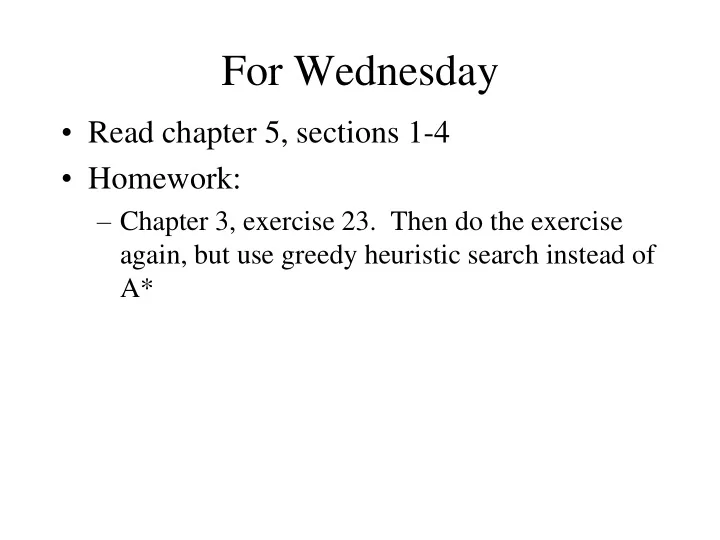

For Wednesday • Read chapter 5, sections 1-4 • Homework: – Chapter 3, exercise 23. Then do the exercise again, but use greedy heuristic search instead of A*
Program 1 • Any questions?
Problem Formulation • States • Initial state • Actions • Transition model • Goal test • Path cost
Informed Search • So far we’ve looked at search methods that require no knowledge of the problem • However, these can be very inefficient • Now we’re going to look at searching methods that take advantage of the knowledge we have a problem to reach a solution more efficiently
Best First Search • At each step, expand the most promising node • Requires some estimate of what is the “most promising node” • We need some kind of evaluation function • Order the nodes based on the evaluation function
Greedy Search • A heuristic function, h(n) , provides an estimate of the distance of the current state to the closest goal state. • The function must be 0 for all goal states • Example: – Straight line distance to goal location from current location for route finding problem
Heuristics Don’t Solve It All • NP-complete problems still have a worst- case exponential time complexity • Good heuristic function can: – Find a solution for an average problem efficiently – Find a reasonably good (but not optimal) solution efficiently
Beam Search • Variation on greedy search • Limit the queue to the best n nodes ( n is the beam width) • Expand all of those nodes • Select the best n of the remaining nodes • And so on • May not produce a solution
Focus on Total Path Cost • Uniform cost search uses g(n) --the path cost so far • Greedy search uses h(n) --the estimated path cost to the goal • What we’d like to use instead is f(n) = g(n) + h(n) to estimate the total path cost
Admissible Heuristic • An admissible heuristic is one that never overestimates the cost to reach the goal. • It is always less than or equal to the actual cost. • If we have such a heuristic, we can prove that best first search using f(n) is both complete and optimal. • A* Search
8-Puzzle Heuristic Functions • Number of tiles out of place • Manhattan Distance • Which is better? • Effective branching factor
Inventing Heuristics • Relax the problem • Cost of solving a subproblem • Learn weights for features of the problem
Local Search • Works from the “current state” • No focus on path • Also useful for optimization problems
Local Search • Advantages? • Disadvantages?
Hill-Climbing • Also called gradient descent • Greedy local search • Move from current state to a state with a better overall value • Issues: – Local maxima – Ridges – Plateaux
Variations on Hill Climbing • Stochastic hill climbing • First-choice hill climbing • Random-restart hill climbing
Evaluation of Hill Climbing
Simulated Annealing • Similar to hill climbing, but-- – We select a random successor – If that successor improves things, we take it – If not, we may take it, based on a probability – Probability gradually goes down
Local Beam Search • Variant of hill-climbing where multiple states and successors are maintained
Genetic Algorithms • Have a population of k states (or individuals ) • Have a fitness function that evaluates the states • Create new individuals by randomly selecting pairs and mating them using a randomly selected crossover point . • More fit individuals are selected with higher probability. • Apply random mutation . • Keep top k individuals for next generation.
Recommend
More recommend